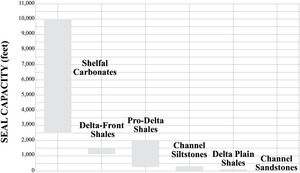Displacement pressure estimation from sedimentary facies and well logs
| Exploring for Oil and Gas Traps | |

| |
| Series | Treatise in Petroleum Geology |
|---|---|
| Part | Predicting the occurrence of oil and gas traps |
| Chapter | Evaluating top and fault seal |
| Author | Grant M. Skerlec |
| Link | Web page |
| Store | AAPG Store |
Displacement pressure has been inferred from the relationship between capillary properties and sedimentary facies.[1][2] Two examples demonstrate the ability to construct regional facies maps and then assign maximum limits to the amount of hydrocarbon that could be trapped beneath these seals.
Example: Ardjuna basin, Indonesia

The top seal and capillary properties of rocks from the Ardjuna basin (offshore Java, Indonesia) are related to mappable facies.[1] The Talang Akar Formation consists of deltaic facies ranging from channel sandstones, delta plain shales, and channel abandonment siltstones to prodelta and delta-front shales as well as shelfal carbonates.
Each of these facies has a distinct range of displacement pressures. Figure 1 shows the range of seal capacities for the different facies. Shelfal carbonates and delta-front shales are excellent seals, with displacement pressures > 1000 psia (air-mercury) and capable of trapping approximately 1000–10,000 ft of oil. Delta-plain shales are relatively poor seals, with displacement pressures of 80–90 psia (air-mercuryo and capable of trapping only 90–100 ft of oil.
These values place an upper limit on the amount of hydrocarbon that can be trapped. Other factors, however, limit the sealing potential of these seals. Seal risk was defined by combining Pd with qualitative assessments of ductility, fracturing, thickness, and lateral continuity.[1]
Example: onshore African basin
A study of an African basin found differences in displacement pressure among flood plain, lacustrine, and overbank facies.[2] Flood plain mudstones have displacement pressures of pressure::1,500 psi (air–mercury) and can trap more than length::300 m depth::(1,000 ft) of oil. Lacustrine and overbank facies contain some siltstones that have displacement pressures of pressure::500 psi (air–mercury) or less. These seal–rock facies can be correlated among wells and used to predict lateral facies variations and seal distribution in uncored wells.
Recent developments
An encouraging development is the attempt to establish a relationship between log response and displacement pressure.[3][2][4][5] Resistivity logs directly reflect the relative proportions of clay minerals and organics to quartz and other minerals. Clay-rich seals with high displacement pressures have low resistivities. Clay-poor rocks with lower displacement pressures have high resistivities.[4]
See also
- Measuring displacement pressure using mercury injection
- Estimating displacement pressure from pore size
References
- ↑ 1.0 1.1 1.2 1.3 Vavra, C. L., J. G. Kaldi, and R. M. Sneider, 1992, Geological applications of capillary pressure: a review: AAPG Bulletin, vol. 76, no. 6, p. 840–850.
- ↑ 2.0 2.1 2.2 Shea, W. T., J. R. Schwalbach, and D. M. Allard, 1993, Integrated rock-log evaluation of fluvio-lacustrine seals, in J. Ebanks, J. Kaldi, and C. Vavra, eds., Seals and Traps: A Multidisciplinary Approach: AAPG Hedberg Research conference, unpublished abstract.
- ↑ Alger, R. P., D. L. Luffel, and R. B. Truman, 1989, New unified method of integrating core capillary pressure data with well logs: Society of Petroleum Formation Evaluation, vol. 4, no. 2, p. 145–152, DOI: 10.2118/16793-PA.
- ↑ 4.0 4.1 Sneider, R. M., and G. Bolger, 1993, Estimating seals from wireline logs of clastic seals and reservoir intervals, in J. Ebanks, J. Kaldi, and C. Vavra, eds., Seals and Traps: A Multidisciplinary Approach: AAPG Hedberg Research conference, unpublished abstract.
- ↑ Sneider, R. M., and J. Neasham, 1993, Comparison of seal capacity determination (SCD) from cores with SCD’s from cuttings of the same interval, in J. Ebanks, J. Kaldi, and C. Vavra, eds., Seals and Traps: A Multidisciplinary Approach: AAPG Hedberg Research Conference, unpublished abstract.